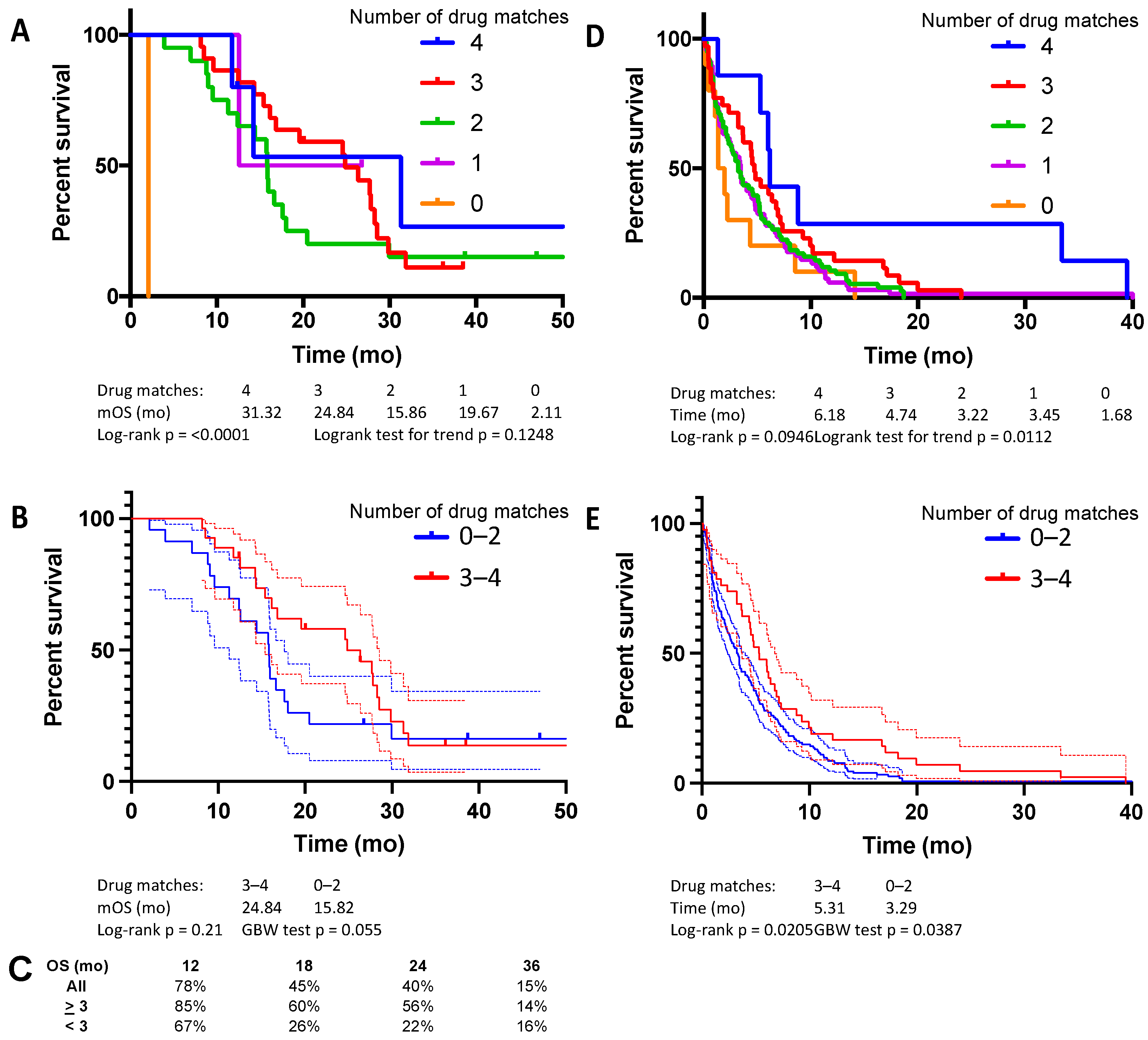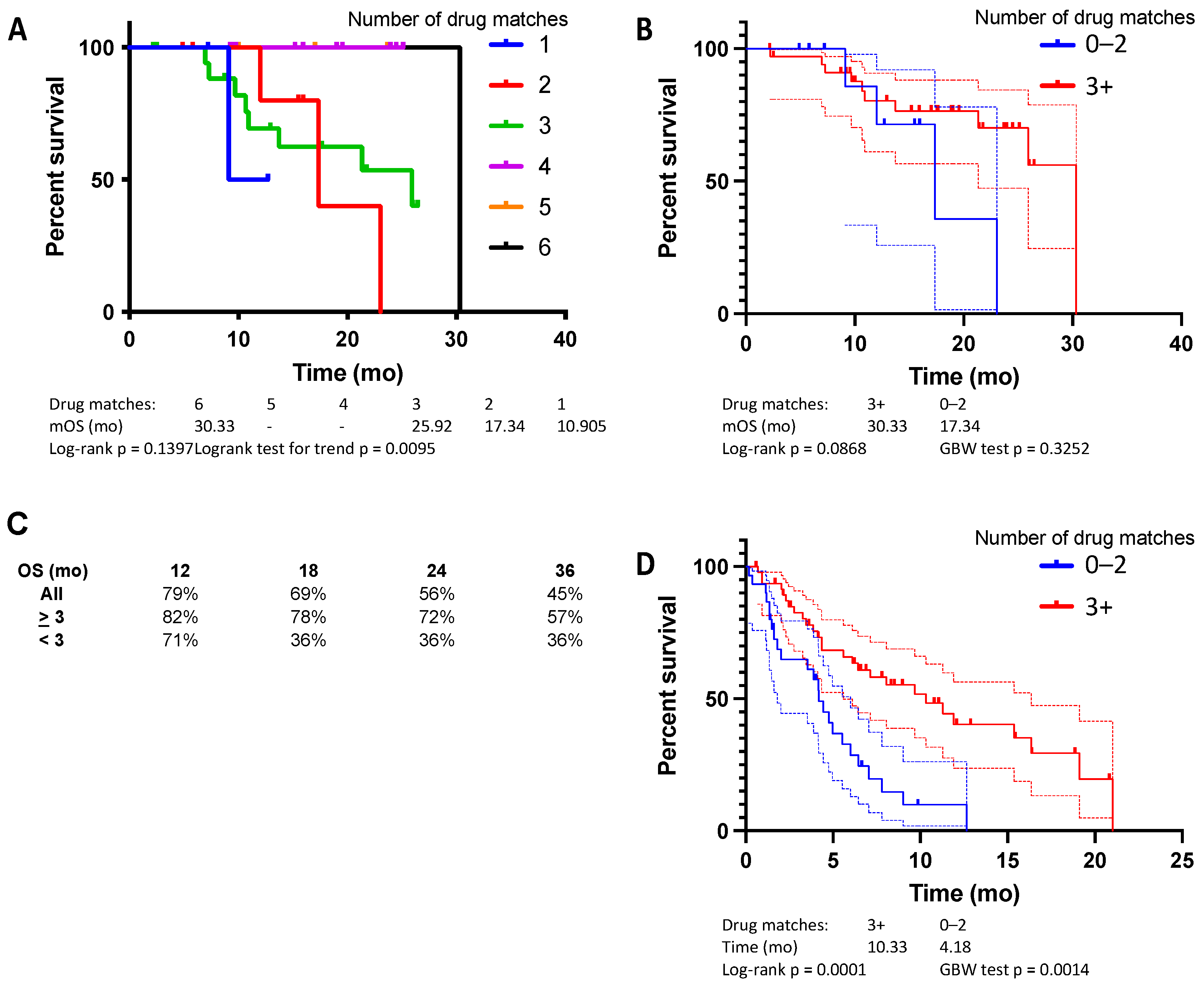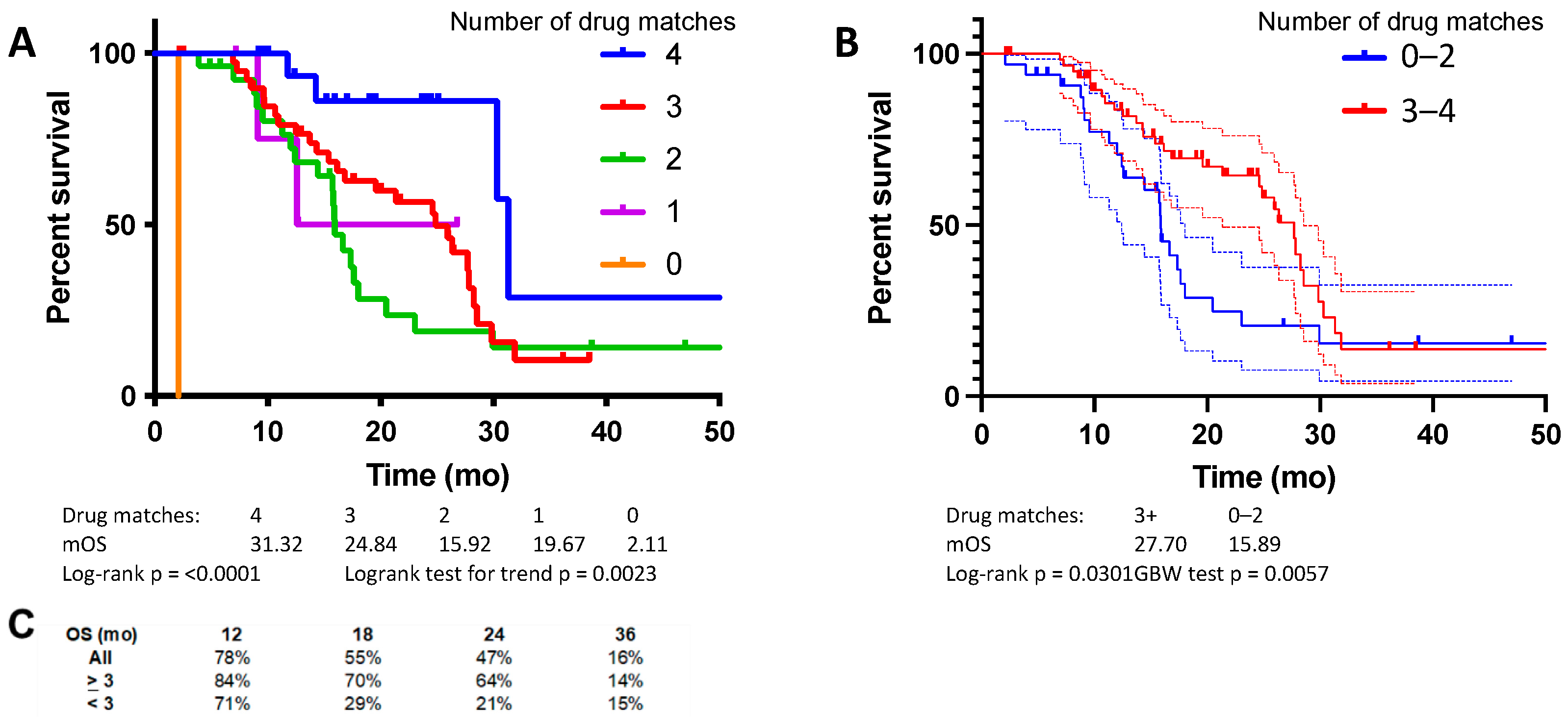ChemoSensitivity Assay Guided Metronomic Chemotherapy Is Safe and Effective for Treating Advanced Pancreatic Cancer
Abstract
:Simple Summary
Abstract
1. Introduction
2. Materials and Methods
2.1. Clinical Trial Design
2.2. Metronomic Chemotherapy (MCT)
2.3. ChemoSensitivity Assay
2.4. Nearest Template Prediction
2.5. Statistical Analysis
3. Results
3.1. Safety and Efficacy of Metronomic Chemotherapy Approach
3.2. ChemoSensitivity Assay
3.3. ChemoSensitivity Assay-Guided MCT, Pilot Cohort
3.4. ChemoSensitivity Assay-Guided MCT, Validation Cohort
3.5. Individual Examples of ChemoSensitivity Assay-Guided MCT
4. Discussion
5. Conclusions
Author Contributions
Funding
Institutional Review Board Statement
Informed Consent Statement
Data Availability Statement
Conflicts of Interest
References
- Siegel, R.L.; Miller, K.D.; Fuchs, H.E.; Jemal, A. Cancer statistics, 2022. CA Cancer J. Clin. 2022, 72, 7–33. [Google Scholar] [CrossRef] [PubMed]
- Conroy, T.; Desseigne, F.; Ychou, M.; Bouche, O.; Guimbaud, R.; Becouarn, Y.; Adenis, A.; Raoul, J.L.; Gourgou-Bourgade, S.; de la Fouchardiere, C.; et al. FOLFIRINOX versus gemcitabine for metastatic pancreatic cancer. N. Engl. J. Med. 2011, 364, 1817–1825. [Google Scholar] [CrossRef] [PubMed] [Green Version]
- Von Hoff, D.D.; Ervin, T.; Arena, F.P.; Chiorean, E.G.; Infante, J.; Moore, M.; Seay, T.; Tjulandin, S.A.; Ma, W.W.; Saleh, M.N.; et al. Increased survival in pancreatic cancer with nab-paclitaxel plus gemcitabine. N. Engl. J. Med. 2013, 369, 1691–1703. [Google Scholar] [CrossRef] [PubMed] [Green Version]
- Wang-Gillam, A.; Li, C.P.; Bodoky, G.; Dean, A.; Shan, Y.S.; Jameson, G.; Macarulla, T.; Lee, K.H.; Cunningham, D.; Blanc, J.F.; et al. Nanoliposomal irinotecan with fluorouracil and folinic acid in metastatic pancreatic cancer after previous gemcitabine-based therapy (NAPOLI-1): A global, randomised, open-label, phase 3 trial. Lancet 2016, 387, 545–557. [Google Scholar] [CrossRef]
- Van Cutsem, E.; Tempero, M.A.; Sigal, D.; Oh, D.Y.; Fazio, N.; Macarulla, T.; Hitre, E.; Hammel, P.; Hendifar, A.E.; Bates, S.E.; et al. Randomized Phase III Trial of Pegvorhyaluronidase Alfa With Nab-Paclitaxel Plus Gemcitabine for Patients With Hyaluronan-High Metastatic Pancreatic Adenocarcinoma. J. Clin. Oncol. 2020, 38, 3185–3194. [Google Scholar] [CrossRef]
- Bekaii-Saab, T.; Okusaka, T.; Goldstein, D.; Oh, D.; Ueno, M.; Ioka, T.; Fang, W.; Anderson, E.C.; Noel, M.S.; Reni, M.; et al. Napabucasin + nab-paclitaxel with gemcitabine in patients (pts) with metastatic pancreatic adenocarcinoma (mPDAC): Results from the phase III CanStem111P study. Ann. Oncol. 2021, 32, S1084–S1095. [Google Scholar] [CrossRef]
- Hecht, J.R.; Lonardi, S.; Bendell, J.; Sim, H.W.; Macarulla, T.; Lopez, C.D.; Van Cutsem, E.; Munoz Martin, A.J.; Park, J.O.; Greil, R.; et al. Randomized Phase III Study of FOLFOX Alone or With Pegilodecakin as Second-Line Therapy in Patients With Metastatic Pancreatic Cancer That Progressed After Gemcitabine (SEQUOIA). J. Clin. Oncol. 2021, 39, 1108–1118. [Google Scholar] [CrossRef]
- Tempero, M.; Oh, D.; Macarulla, T.; Reni, M.; Van Cutsem, E.; Hendifar, A.; Waldschmidt, D.; Starling, N.; Bachet, J.; Chang, H.; et al. Ibrutinib in combination with nab-paclitaxel and gemcitabine as first-line treatment for patients with metastatic pancreatic adenocarcinoma: Results from the phase 3 RESOLVE study. Ann. Oncol. 2019, 30 (Suppl. 4), iv126. [Google Scholar] [CrossRef]
- Golan, T.; Hammel, P.; Reni, M.; Van Cutsem, E.; Macarulla, T.; Hall, M.J.; Park, J.O.; Hochhauser, D.; Arnold, D.; Oh, D.Y.; et al. Maintenance Olaparib for Germline BRCA-Mutated Metastatic Pancreatic Cancer. N. Engl. J. Med. 2019, 381, 317–327. [Google Scholar] [CrossRef]
- Jameson, G.S.; Borazanci, E.; Babiker, H.M.; Poplin, E.; Niewiarowska, A.A.; Gordon, M.S.; Barrett, M.T.; Rosenthal, A.; Stoll-D’Astice, A.; Crowley, J.; et al. Response Rate Following Albumin-Bound Paclitaxel Plus Gemcitabine Plus Cisplatin Treatment Among Patients With Advanced Pancreatic Cancer: A Phase 1b/2 Pilot Clinical Trial. JAMA Oncol. 2019, 6, 125–132. [Google Scholar] [CrossRef]
- Reni, M.; Zanon, S.; Balzano, G.; Passoni, P.; Pircher, C.; Chiaravalli, M.; Fugazza, C.; Ceraulo, D.; Nicoletti, R.; Arcidiacono, P.G.; et al. A randomised phase 2 trial of nab-paclitaxel plus gemcitabine with or without capecitabine and cisplatin in locally advanced or borderline resectable pancreatic adenocarcinoma. Eur. J. Cancer 2018, 102, 95–102. [Google Scholar] [CrossRef] [PubMed]
- Ahn, D.H.; Krishna, K.; Blazer, M.; Reardon, J.; Wei, L.; Wu, C.; Ciombor, K.K.; Noonan, A.M.; Mikhail, S.; Bekaii-Saab, T. A modified regimen of biweekly gemcitabine and nab-paclitaxel in patients with metastatic pancreatic cancer is both tolerable and effective: A retrospective analysis. Ther. Adv. Med. Oncol. 2017, 9, 75–82. [Google Scholar] [CrossRef] [PubMed]
- Romiti, A.; Falcone, R.; Roberto, M.; Marchetti, P. Tackling pancreatic cancer with metronomic chemotherapy. Cancer Lett. 2017, 394, 88–95. [Google Scholar] [CrossRef] [PubMed]
- Isacoff, W.H.; Reber, H.A.; Bedford, R.; Hoos, W.; Rahib, L.; Upfill-Brown, A.; Donahue, T.; Hines, O.J. Low-Dose Continuous 5-Fluorouracil Combined with Leucovorin, nab-Paclitaxel, Oxaliplatin, and Bevacizumab for Patients with Advanced Pancreatic Cancer: A Retrospective Analysis. Target Oncol. 2018, 13, 461–468. [Google Scholar] [CrossRef] [Green Version]
- Sahai, V.; Saif, M.W.; Kalyan, A.; Philip, P.A.; Rocha-Lima, C.M.; Ocean, A.; Ondovik, M.S.; Simeone, D.M.; Banerjee, S.; Bhore, R.; et al. A Phase I/II Open-Label Multicenter Single-Arm Study of FABLOx (Metronomic 5-Fluorouracil Plus nab-Paclitaxel, Bevacizumab, Leucovorin, and Oxaliplatin) in Patients with Metastatic Pancreatic Cancer. J. Pancreat. Cancer 2019, 5, 35–42. [Google Scholar] [CrossRef] [Green Version]
- Yu, K.H.; Ricigliano, M.; McCarthy, B.; Chou, J.F.; Capanu, M.; Cooper, B.; Bartlett, A.; Covington, C.; Lowery, M.A.; O’Reilly, E.M. Circulating Tumor and Invasive Cell Gene Expression Profile Predicts Treatment Response and Survival in Pancreatic Adenocarcinoma. Cancers 2018, 10, 467. [Google Scholar] [CrossRef] [Green Version]
- Yu, K.H.; Park, J.; Mittal, A.; Abou-Alfa, G.K.; El Dika, I.; Epstein, A.S.; Ilson, D.H.; Kelsen, D.P.; Ku, G.Y.; Li, J.; et al. Circulating Tumor and Invasive Cell Expression Profiling Predicts Effective Therapy in Pancreatic Cancer. Cancer, 2022; in press. [Google Scholar] [CrossRef]
- Lu, J.; Fan, T.; Zhao, Q.; Zeng, W.; Zaslavsky, E.; Chen, J.J.; Frohman, M.A.; Golightly, M.G.; Madajewicz, S.; Chen, W.T. Isolation of circulating epithelial and tumor progenitor cells with an invasive phenotype from breast cancer patients. Int. J. Cancer 2010, 126, 669–683. [Google Scholar] [CrossRef] [Green Version]
- Paris, P.L.; Kobayashi, Y.; Zhao, Q.; Zeng, W.; Sridharan, S.; Fan, T.; Adler, H.L.; Yera, E.R.; Zarrabi, M.H.; Zucker, S.; et al. Functional phenotyping and genotyping of circulating tumor cells from patients with castration resistant prostate cancer. Cancer Lett. 2009, 277, 164–173. [Google Scholar] [CrossRef]
- Fan, T.; Zhao, Q.; Chen, J.J.; Chen, W.T.; Pearl, M.L. Clinical significance of circulating tumor cells detected by an invasion assay in peripheral blood of patients with ovarian cancer. Gynecol. Oncol. 2009, 112, 185–191. [Google Scholar] [CrossRef] [Green Version]
- Yu, K.H.; Ricigliano, M.; Hidalgo, M.; Abou-Alfa, G.K.; Lowery, M.A.; Saltz, L.B.; Crotty, J.F.; Gary, K.; Cooper, B.; Lapidus, R.; et al. Pharmacogenomic modeling of circulating tumor and invasive cells for prediction of chemotherapy response and resistance in pancreatic cancer. Clin. Cancer Res. 2014, 20, 5281–5289. [Google Scholar] [CrossRef] [PubMed] [Green Version]
- Hoshida, Y.; Villanueva, A.; Kobayashi, M.; Peix, J.; Chiang, D.Y.; Camargo, A.; Gupta, S.; Moore, J.; Wrobel, M.J.; Lerner, J.; et al. Gene expression in fixed tissues and outcome in hepatocellular carcinoma. N. Engl. J. Med. 2008, 359, 1995–2004. [Google Scholar] [CrossRef] [Green Version]
- Xu, L.; Shen, S.S.; Hoshida, Y.; Subramanian, A.; Ross, K.; Brunet, J.P.; Wagner, S.N.; Ramaswamy, S.; Mesirov, J.P.; Hynes, R.O. Gene expression changes in an animal melanoma model correlate with aggressiveness of human melanoma metastases. Mol. Cancer Res. 2008, 6, 760–769. [Google Scholar] [CrossRef] [Green Version]
- Reiner, A.; Yekutieli, D.; Benjamini, Y. Identifying differentially expressed genes using false discovery rate controlling procedures. Bioinformatics 2003, 19, 368–375. [Google Scholar] [CrossRef] [PubMed]
- Kim, J.J.; Tannock, I.F. Repopulation of cancer cells during therapy: An important cause of treatment failure. Nat. Rev. Cancer 2005, 5, 516–525. [Google Scholar] [CrossRef] [PubMed]
- Filippi, R.; Lombardi, P.; Depetris, I.; Fenocchio, E.; Quara, V.; Chila, G.; Aglietta, M.; Leone, F. Rationale for the use of metronomic chemotherapy in gastrointestinal cancer. Expert Opin. Pharmacother. 2018, 19, 1451–1463. [Google Scholar] [CrossRef]
- Klement, G.; Baruchel, S.; Rak, J.; Man, S.; Clark, K.; Hicklin, D.J.; Bohlen, P.; Kerbel, R.S. Continuous low-dose therapy with vinblastine and VEGF receptor-2 antibody induces sustained tumor regression without overt toxicity. J. Clin. Investig. 2000, 105, R15–R24. [Google Scholar] [CrossRef] [Green Version]
- Browder, T.; Butterfield, C.E.; Kraling, B.M.; Shi, B.; Marshall, B.; O’Reilly, M.S.; Folkman, J. Antiangiogenic scheduling of chemotherapy improves efficacy against experimental drug-resistant cancer. Cancer Res. 2000, 60, 1878–1886. [Google Scholar]
- Vives, M.; Ginesta, M.M.; Gracova, K.; Graupera, M.; Casanovas, O.; Capella, G.; Serrano, T.; Laquente, B.; Vinals, F. Metronomic chemotherapy following the maximum tolerated dose is an effective anti-tumour therapy affecting angiogenesis, tumour dissemination and cancer stem cells. Int. J. Cancer 2013, 133, 2464–2472. [Google Scholar] [CrossRef] [Green Version]
- Yu, K.H.; McCarthy, B.; Isacoff, W.H.; Cooper, B.; Bartlett, A.; Park, J.; Purcell, F.; McCarthy, D.; O’Reilly, E.M. Pharmacogenomic blood-based assay to predict chemotherapy response and survival in pancreatic cancer. J. Clin. Oncol. 2020, 38, 738. [Google Scholar] [CrossRef]
- Premasekharan, G.; Gilbert, E.; Okimoto, R.A.; Hamirani, A.; Lindquist, K.J.; Ngo, V.T.; Roy, R.; Hough, J.; Edwards, M.; Paz, R.; et al. An improved CTC isolation scheme for pairing with downstream genomics: Demonstrating clinical utility in metastatic prostate, lung and pancreatic cancer. Cancer Lett. 2016, 380, 144–152. [Google Scholar] [CrossRef] [PubMed]
- Deeley, R.G.; Westlake, C.; Cole, S.P. Transmembrane transport of endo- and xenobiotics by mammalian ATP-binding cassette multidrug resistance proteins. Physiol. Rev. 2006, 86, 849–899. [Google Scholar] [CrossRef] [PubMed] [Green Version]
- Gottesman, M.M.; Ling, V. The molecular basis of multidrug resistance in cancer: The early years of P-glycoprotein research. FEBS Lett. 2006, 580, 998–1009. [Google Scholar] [CrossRef] [Green Version]
- Ross, D.D.; Nakanishi, T. Impact of breast cancer resistance protein on cancer treatment outcomes. Methods Mol. Biol. 2010, 596, 251–290. [Google Scholar] [CrossRef]
- Li, Q.; Shu, Y. Role of solute carriers in response to anticancer drugs. Mol. Cell. Ther. 2014, 2, 15. [Google Scholar] [CrossRef] [PubMed] [Green Version]
- He, L.; Vasiliou, K.; Nebert, D.W. Analysis and update of the human solute carrier (SLC) gene superfamily. Hum. Genom. 2009, 3, 195–206. [Google Scholar] [CrossRef] [Green Version]
- Lemstrova, R.; Soucek, P.; Melichar, B.; Mohelnikova-Duchonova, B. Role of solute carrier transporters in pancreatic cancer: A review. Pharmacogenomics 2014, 15, 1133–1145. [Google Scholar] [CrossRef]



| Characteristics | Pilot Cohort | Validation Cohort |
|---|---|---|
| Total, N | 50 | 45 |
| Age, Y, median | 62 | 74 |
| Gender, N (%) | ||
| Male | 26 (52) | 28 (62) |
| Female | 24 (48) | 17 (38) |
| Stage | ||
| IV | 50 (100) | 45 (100) |
| Disease location (%) | ||
| Locally recurrent | 15 (30) | 10 (22) |
| Liver | 33 (66) | 24 (53) |
| Lung | 7 (14) | 3 (7) |
| Peritoneum | 2 (4) | 11 (24) |
| Frontline regimen contains | ||
| 5-FU | 43 (86) | 25 (56) |
| Nab-paclitaxel | 31 (62) | 34 (76) |
| Irinotecan | 23 (46) | 15 (33) |
| Oxaliplatin | 21 (42) | 34 (76) |
| Gemcitabine | 20 (40) | 33 (73) |
| Mitomycin-C | 16 (32) | 8 (18) |
| Cisplatin | 11 (22) | 3 (7) |
| Toxicity | Grade (%) | |||
|---|---|---|---|---|
| I | II | III | IV | |
| Fatigue | 18 (38) | 26 (55) | 3 (6) | 0 (0) |
| Anorexia | 24 (51) | 12 (26) | 7 (15) | 0 (0) |
| Drug allergy | 0 (0) | 5 (11) | 3 (6) | 0 (0) |
| Nausea | 21 (45) | 20 (43) | 2 (4) | 0 (0) |
| Vomiting | 8 (17) | 13 (28) | 2 (4) | 0 (0) |
| Stomatitis | 13 (28) | 7 (15) | 6 (13) | 0 (0) |
| Diarrhea | 9 (19) | 19 (40) | 4 (9) | 0 (0) |
| Weight loss | 23 (49) | 2 (4) | 6 (13) | 0 (0) |
| Hypertension | 0 (0) | 10 (21) | 6 (13) | 0 (0) |
| Renal insufficiency | 0 (0) | 4 (9) | 3 (6) | 4 (9) * |
| Neuropathy | 12 (26) | 11 (23) | 2 (4) | 1 (2) |
| Hearing loss | 2 (4) | 0 (0) | 1 (2) | 0 (0) |
| Anemia | 7 (15) | 20 (43) | 16 (34) | 2 (4) |
| Neutropenia | 9 (19) | 10 (21) | 7 (15) | 11 (23) |
| Thrombocytopenia | 9 (19) | 12 (26) | 9 (19) | 8 (17) |
Publisher’s Note: MDPI stays neutral with regard to jurisdictional claims in published maps and institutional affiliations. |
© 2022 by the authors. Licensee MDPI, Basel, Switzerland. This article is an open access article distributed under the terms and conditions of the Creative Commons Attribution (CC BY) license (https://creativecommons.org/licenses/by/4.0/).
Share and Cite
Isacoff, W.H.; Cooper, B.; Bartlett, A.; McCarthy, B.; Yu, K.H. ChemoSensitivity Assay Guided Metronomic Chemotherapy Is Safe and Effective for Treating Advanced Pancreatic Cancer. Cancers 2022, 14, 2906. https://doi.org/10.3390/cancers14122906
Isacoff WH, Cooper B, Bartlett A, McCarthy B, Yu KH. ChemoSensitivity Assay Guided Metronomic Chemotherapy Is Safe and Effective for Treating Advanced Pancreatic Cancer. Cancers. 2022; 14(12):2906. https://doi.org/10.3390/cancers14122906
Chicago/Turabian StyleIsacoff, William H., Brandon Cooper, Andrew Bartlett, Brian McCarthy, and Kenneth H. Yu. 2022. "ChemoSensitivity Assay Guided Metronomic Chemotherapy Is Safe and Effective for Treating Advanced Pancreatic Cancer" Cancers 14, no. 12: 2906. https://doi.org/10.3390/cancers14122906
APA StyleIsacoff, W. H., Cooper, B., Bartlett, A., McCarthy, B., & Yu, K. H. (2022). ChemoSensitivity Assay Guided Metronomic Chemotherapy Is Safe and Effective for Treating Advanced Pancreatic Cancer. Cancers, 14(12), 2906. https://doi.org/10.3390/cancers14122906






